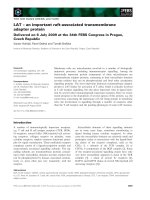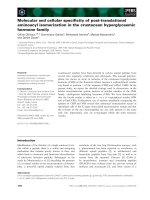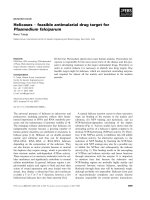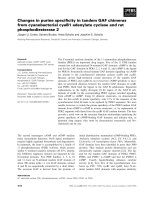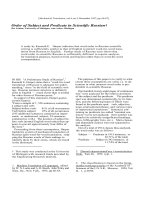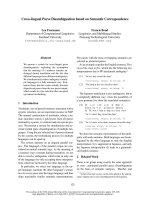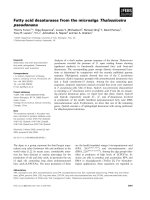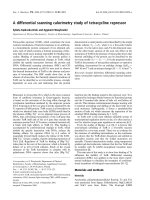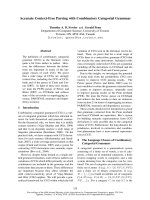Báo cáo khoa học: NO synthase isoforms specifically modify peroxynitrite reactivity pptx
Bạn đang xem bản rút gọn của tài liệu. Xem và tải ngay bản đầy đủ của tài liệu tại đây (355.55 KB, 11 trang )
NO synthase isoforms specifically modify peroxynitrite
reactivity
Amandine Mare
´
chal
1
, Tony A. Mattioli
1
, Dennis J. Stuehr
2
and Je
´
ro
ˆ
me Santolini
1
1 Laboratoire Stress Oxydant et De
´
toxication, iBiTec-S, CEA Saclay, Gif-sur-Yvette Cedex, France
2 Department of Pathobiology, Lerner Research Institute, Cleveland Clinic, Cleveland, OH, USA
Introduction
Nitric oxide synthases (NOSs) play an atypical role
among the vast family of hemoproteins. Like cyto-
chromes P450 and other hemothiolate proteins, their
heme moiety performs highly selective and effective
oxidation of substrates via the activation of dioxygen.
However, the catalytic properties of NOSs are such
that they lead to the biosynthesis of nitric oxide (NO)
[1–3].
NOSs are homodimers comprising two distinct
domains with specific catalytic roles. The reductase
domain [4] is a flavoprotein with a ferredoxin-NADP-
reductase motif that shuttles electrons [5,6] from
NADPH via two co-factors (flavin adenine dinucleo-
tide and flavin mononucleotide) to the oxygenase
domain where the catalytic reaction takes place. The
catalytic site comprises a heme B that is linked to the
Keywords
detoxification; NO synthase; oxidative
stress; peroxynitrite; reactive nitrogen
species
Correspondence
J. Santolini, Laboratoire Stress Oxydant et
De
´
toxication, iBiTec-S and CNRS URA 2096,
CEA Saclay, 91191 Gif-sur-Yvette Cedex,
France
Fax: +33 1 69 08 87 17
Tel: +33 1 69 08 53 63
E-mail:
(Received 12 May 2010, revised 8 July
2010, accepted 22 July 2010)
doi:10.1111/j.1742-4658.2010.07786.x
Nitric oxide synthases (NOSs) are multi-domain hemothiolate proteins that
are the sole source of nitric oxide (NO) in mammals. NOSs can also be a
source or a sink for peroxynitrite (PN), an oxidant that is suspected to be
involved in numerous physiopathological processes. In a previous study,
we showed that the oxygenase domain of the inducible NOS (iNOSoxy)
reacts with PN and changes its oxidative reactivity [Mare
´
chal A, Mattioli
TA, Stuehr DJ & Santolini J (2007) J Biol Chem 282, 14101–14112]. Here
we report a similar analysis on two other NOS isoforms, neuronal NOS
(nNOS) and a bacterial NOS-like protein (bsNOS). All NOSs accelerated
PN decomposition, with accumulation of a similar heme intermediate. The
kinetics of PN decomposition and heme transitions were comparable
among NOSs. However, their effects on PN reactivity differ greatly. All
isoforms suppressed PN two-electron oxidative activity, but iNOSoxy
enhanced PN one-electron oxidation and nitration potencies, the oxygenase
domain of nNOS (nNOSoxy) affected them minimally, and bsNOS
abolished all PN reactivities. This led to the loss of both NOS and PN
decomposition activities for nNOSoxy and iNOSoxy, which may be linked
to the reported alterations in their electronic absorption spectra. Bacterial
bsNOS was affected to a lesser extent by reaction with PN. We propose
that these differences in PN reactivity among NOSs might arise from subtle
differences in their heme pockets, and could reflect the physiological speci-
ficity of each NOS isoform, ranging from oxidative stress amplification
(iNOS) to detoxification (bsNOS).
Abbreviations
Arg,
L-arginine; bsNOS, NOS-like protein isolated from Bacillus subtilis; CpII, compound II of the chloroperoxidase and catalase catalytic
cycle; DHR, dihydrorhodamine; DTPA, diethylenetriaminepentaacetic acid; eNOS, endothelial nitric oxide synthase; H
4
B, tetrahydrobiopterin,
(6R)-5,6,7,8-tetrahydro-
L-biopterin; HPA, 4-hydroxyphenylacetic acid; HPA-NO
2
, 3-nitroHPA; di-HPA, HPA dimer; iNOS, inducible nitric oxide
synthase; nNOS, neuronal nitric oxide synthase; NO, nitric oxide; NOS, nitric oxide synthase; NOSoxy, oxygenase domain of NOS;
PN, peroxynitrite; RNS, reactive nitrogen species.
FEBS Journal 277 (2010) 3963–3973 ª 2010 C. E. A. Journal compilation ª 2010 FEBS 3963
protein backbone by a proximal cysteine ligand [7].
The NOS heme catalyzes the two-step oxidation of
l-arginine (Arg) [8] using 6R-tetrahydrobiopterin
(H
4
B) as an additional electron donor [9]. The first
step, presumably similar to the mono-oxygenation
mechanism of cytochromes P450, converts Arg into
N
x
-hydroxy-l-arginine [10]. The second step, specific
to NOSs, converts N
x
-hydroxy-l-arginine into citrul-
line, with NO being formed as a by-product [11,12].
This subtly regulated mechanism [13] is shared by
numerous NOS isoforms and by a number of known
NOS-like proteins (e.g. bacterial NOS-like proteins
[14]). Despite similar 3D structures and catalytic
mechanisms [1,7,15–18], NOSs display different if not
contrary physiological activities. Constitutive mamma-
lian NOSs (endothelial and neuronal NOSs, eNOS and
nNOS) are involved in cGMP signaling cascades, and
are implicated in the regulation of vascular tone or in
neuronal communication [19,20]. Inducible NOS
(iNOS) is involved in cytotoxic activities, such as the
non-specific immune response [21,22]. The roles of
bacterial NOS-like proteins remain mostly unknown
[23–26], but several pieces of evidence indicate that
they do not share the same catalytic mechanism as
mammalian NOSs [27,28].
The variety of biological roles among NOS isoforms
may be the result of the rich chemistry of NO [29].
Indeed, generation of secondary products called reac-
tive nitrogen species (RNS) has been suggested to
explain the various physiological effects of NO. For
instance, peroxynitrite (PN), a powerful oxidative and
nitrative agent, is commonly associated with the cyto-
toxic and pathological activities of NOSs [30–33]. PN
is believed to form in cells via the stoichiometric reac-
tion of NO and superoxide anion (O
2
°
)
) [34,35]. How-
ever, NOS may also produce PN directly, either
through ‘uncoupling’ conditions, in which both NO
and O
2
°
)
are formed [36–38], or via oxidation of the
transient Fe
II
NO complex [39,40].
Once produced, PN may be activated by Lewis acids
such as protons, metals or metalloproteins [41,42]. PN
activation has been reported for several hemoproteins
[43–45]. However, their effect on PN chemical reactiv-
ity varies from PN isomerisation and scavenging for
globins [43] to increased nitration activity for hemothio-
late proteins [46]. This apparent discrepancy remains
unexplained despite several reports on the mechanism
of PN activation [47,48].
In a previous study, we showed that the heme-con-
taining oxygenase domain of inducible NO synthase
(iNOSoxy) was able to activate PN, accelerating its
decomposition rate and changing its chemical reactiv-
ity to promote one-electron oxidation and nitration
[49]. Here we report a similar analysis on two other
NOS isoforms: the constitutive nNOS and a NOS-like
protein from Bacillus subtilis (bsNOS). We analyzed
their capacity to accelerate PN decomposition,
the kinetics of NOS-induced PN activation, and the
related heme transitions. We also investigated the
effect of such activation on PN reactivity and NOS
properties.
Results
All NOS isoforms activate PN decomposition
We studied the effects of the heme environment on PN
decomposition kinetics by comparing three NOS iso-
forms (iNOSoxy, nNOSoxy and bsNOS) that exhibit
different physico-chemical properties. NOS solutions
were rapid-mixed with PN at room temperature, and
PN decomposition was monitored by absorbance
changes at 302 nm (see Experimental procedures).
Figure 1A shows the PN apparent decay rates (k
obs
)as
a function of nNOSoxy and bsNOS concentrations.
Data previously obtained for iNOSoxy [49] are super-
imposed for comparison. Both nNOSoxy and bsNOS
accelerate PN decomposition, with second-order rate
constants for PN activation (k
act
) of 23.5 ± 2.0 · 10
4
and 13.3 ± 1.5 · 10
4
m
)1
Æs
)1
, respectively (Table 1).
As expected, no significant changes in PN spontaneous
decomposition rates (y intercept) were noted as all
data were obtained at the same pH value.
NOS isoforms share similar mechanism of PN
decomposition
Superimposed absorption spectra showed that the
kinetics of PN decomposition correlate with nNOSoxy
and bsNOS heme spectral changes (Fig. S1B–D), as
reported for iNOSoxy [49]. This confirms the involve-
ment of NOS heme in the mechanism of PN decompo-
sition for all NOSs. Analysis of the kinetic phases of
PN activation by nNOSoxy at pH 6.4 (Fig. S1A,B)
and by bsNOS at pH 7.4 (Fig. S1C,D) led to observa-
tions similar to those reported for iNOSoxy [49]. A
series of transitions takes place during an initial phase
(within a few milliseconds) that precedes the transient
accumulation of a similar reaction intermediate
(Fig. S1B–D) for all NOSs. The UV-visible absorption
spectrum of the intermediate (Fig. 1B) is characterized
by a Soret band between 442 and 447 nm and the
presence of Q-b and -a absorption bands at approxi-
mately 550 and 590 nm. In the case of bsNOS, the
Soret band is slightly shifted to the red (447 nm), and
is broader (full width at half maximum of 52 nm) than
The interaction of NOS with peroxynitrite might determine its physiological specificity A. Mare
´
chal et al.
3964 FEBS Journal 277 (2010) 3963–3973 ª 2010 C. E. A. Journal compilation ª 2010 FEBS
those observed for iNOSoxy and nNOSoxy (position
442 nm; full widths at half maximum of 36 and 30 nm,
respectively). The accumulation and decay kinetics of
this intermediate were fitted to a mono-exponential
function for each isoform under the same concentra-
tion and pH conditions (data not shown). nNOSoxy
and iNOSoxy intermediates showed similar formation
and decay rates, and similar PN activation rates,
whereas bsNOS exhibits two- to threefold slower for-
mation and decay rates and a slower PN activation
rate (Table 1). As observed for iNOSoxy [49], the last
phase after PN consumption corresponds to the
appearance of a modified ferric nNOSoxy species with
absorption bands at 413 and 624 nm, distinct from
native nNOSoxy, which is characterized by a Soret
absorption band at approximately 417 nm and a
Fe fi S charge transfer band at 650 nm (Fig. S1A,B).
The bsNOS final spectrum is unaltered, with a Soret
band at 404 nm and no absorbance change at approxi-
mately 624 nm (Fig. S1C,D). These results show that
all NOSs bind PN at the heme and accelerate PN
decomposition, with transient accumulation of a simi-
lar reaction intermediate. However, bsNOS does not
show the same spectral modifications as mammalian
NOSs upon PN activation.
NOS isoforms diversely modify PN oxidative
properties
We investigated the effect of nNOSoxy and bsNOS
activation on PN reactivity. The method was identi-
cal to that one previously reported for iNOSoxy [49]
(see Experimental procedures). The two-electron oxi-
dation reactivity of PN was assessed by comparing
the production of rhodamine from dihydrorhodamine
(DHR) in the absence and presence of NOS
(Fig. 2A,B). The one-electron oxidation reactivity
of PN was assessed by comparing the production of
4-hydroxy-phenylacetic acid dimers (di-HPA) from
4-hydroxy-phenylacetic acid (HPA) under the same
conditions (Fig. 2C,D). As PN is known to be able
to nitrate HPA to give HPA-NO
2
, the same HPA
probe was also used to characterize the nitrative
power of PN in the absence and presence of NOS
(Fig. 2E,F). All data were fitted to a linear function
of PN concentration to quantify PN reactivity in the
absence and presence of NOS isoforms. Figure 3
compares the effect of NOS isoforms on the oxidation
Table 1. Kinetic parameters for the reaction of PN with iNOSoxy,
nNOSoxy and bsNOS. PN (100 l
M) was rapid-mixed with increasing
concentrations of NOS isoforms in gas-free 0.1
M KPi pH 7.4
buffer. Time traces of PN decay at 302 nm were fitted to a mono-
exponential function. The observed rate of PN decomposition
increases linearly with NOS concentration. The calculated slope
represents the constant of activation of PN decomposition by NOS
(k
act
). Heme spectral changes were analyzed upon reaction of
100 l
M PN with 4 lM NOS. Characteristic intermediates were
observed at 443 nm (nNOSoxy and iNOSoxy) and 447 nm (bsNOS).
Time traces at 443 and 447 nm were fitted to mono-exponential
functions to obtain k
build
(accumulation of intermediate) and k
decay
(decay of intermediate).
k
act
(10
4
M
)1
Æs
)1
) k
build
(s
)1
) k
decay
(s
)1
)
iNOSoxy 21.0 ± 2.0 14.8 ± 1.5 1.22 ± 0.04
nNOSoxy 23.5 ± 2.0 16.1 ± 4.1 1.02 ± 0.05
bsNOS 13.3 ± 1.5 6.0 ± 0.1 0.40 ± 0.01
12345
0.0
0.5
1.0
k
obs
(s
–1
)
[NOS] (µM)
nNOSoxy
bsNOS
iNOSoxy
400 500 600 700
0.00
0.01
0.02
0.03
0.04
Absorption
Wavelength (nm)
bsNOS
nNOSoxy
iNOSoxy
Fig. 1. Activation of peroxynitrite decomposition by the various
NOSs. Top panel: 100 l
M PN were rapid-mixed with increasing
concentrations of nNOSoxy or bsNOS at pH 7.4. Conditions were
as described in Experimental procedures. Kinetics of the 302 nm
absorption decay were fitted to mono-exponential functions. The
apparent decay rate constants (k
obs
) are plotted as a function of the
concentrations of nNOSoxy (open circles) and bsNOS (stars).
Curves were fitted to a linear function to determine the rate con-
stant for PN decomposition activation (k
act
, slope) and PN sponta-
neous decomposition rate (k
dec
, y intercept). Values are reported in
Table 1. Data for iNOSoxy are from [49]. Lower panel: extracted
spectra of the intermediates observed on reaction of 100 l
M PN
with 4 l
M bsNOS at pH 7.4 (dotted line), nNOSoxy at pH 6.4
(dashed line) and iNOSoxy at pH 6.4 (solid line, data taken from
[49]).
A. Mare
´
chal et al. The interaction of NOS with peroxynitrite might determine its physiological specificity
FEBS Journal 277 (2010) 3963–3973 ª 2010 C. E. A. Journal compilation ª 2010 FEBS 3965
and nitration properties of PN. The bars indicate the
percentage of reactivity when PN is activated by NOS
compared to PN alone. Data obtained for iNOSoxy
are included for comparison [49]. As previously
reported, iNOSoxy quenches the PN two-electron oxi-
dation capacity ()56%) but increases its one-electron
oxidation and nitration properties (+40 and +90%,
respectively). Although nNOSoxy suppresses the PN
two-electron oxidation ability ()72%), it does not
drastically modify its one-electron oxidation and nitra-
tion properties ()18% and +20%, respectively). On
the contrary, bsNOS appears to suppress all chemical
reactivities of PN by 86%, 83% and 70%, respectively
(Fig. 3).
Effect of NOS-induced PN activation on NOS
activity
We analyzed the effect of PN addition and NOS-
induced activation on the NOS absorption spectrum.
Ten to fifteen successive additions of four NOS equiva-
lents of PN were mixed with NOS samples in the
absence of substrate and co-factor (see Experimental
procedures). UV-visible absorption spectra of the
NOSs were recorded after each PN addition (Fig. 4).
PN addition resulted in significant modification of
the iNOSoxy absorption spectrum (Fig. 4C). A new
absorption band appeared at 624 nm, together with
flattening of the a ⁄ b region, resulting in disappearance
0
100
200
300
400
Rhodamine
Fluorescence (a.u.)
0
50
100
150
0
10
20
30
di-HPA
Fluorescence (a.u.)
050100150
050100150
0123
0123
0
250
500
0.0
0.5
0123
0123
0.0
0.5
HPA-NO
2
, a.u.
[Peroxynitrite] (mM)
A
C
E
B
D
F
Fig. 2. Modification of peroxynitrite oxidative and nitrative properties by nNOSoxy and bsNOS. (A,B) DHR two-electron oxidation as a func-
tion of PN concentration. Fluorescence spectra of rhodamine (k
excitation
500 nm) were recorded after reaction with various concentrations of
peroxynitrite (0, 25, 75, 125 and 175 l
M). Fluorescence emission at 525 nm was plotted as a function of PN concentration in the absence
of NOS (filled circles) or in the presence of 20 l
M nNOSoxy (A, open squares) or bsNOS (B, open squares). (C,D) HPA dimerization as a
function of PN concentration. Fluorescence spectra of di-HPA (k
excitation
326 nm) were recorded for various concentrations of peroxynitrite
(0, 0.5, 1, 2 and 3 m
M). Fluorescence emission at 405 nm was plotted as a function of PN concentration in the absence of NOSs (filled
circles) or in the presence of 20 l
M nNOSoxy (C, open squares) or bsNOS (D, open squares). (E,F). Analysis by reverse-phase HPLC of
HPA-NO
2
production upon reaction of HPA with peroxynitrite. Conditions are described in Experimental procedures. HPA-NO
2
production
was plotted as a function of PN concentration in the absence of NOS (filled circles) or in the presence of 20 l
M nNOSoxy (E, open squares)
and bsNOS (F, open squares). All curves were fitted to linear functions to compare the oxidative properties of free and NOS-activated perox-
ynitrite. a.u., arbitrary unit.
The interaction of NOS with peroxynitrite might determine its physiological specificity A. Mare
´
chal et al.
3966 FEBS Journal 277 (2010) 3963–3973 ª 2010 C. E. A. Journal compilation ª 2010 FEBS
of the 543 nm band. In parallel, the Soret band shifts
from 420 to 411 nm upon PN addition, as observed by
Huhmer et al. [50]. Although the first transition is
complete after five successive additions, the Soret shift
is not yet complete after ten additions, suggesting that
the transitions might correspond to distinct structural
effects. The same experiments were repeated with
nNOSoxy and bsNOS. The nNOSoxy spectral changes
match those observed for iNOSoxy, although to a les-
ser extent: the Soret band is blue-shifted (413 nm after
15 additions), and a similar absorption bands appears
at 620 nm (Fig. 4A). The pattern is notably different
for bsNOS. We did not detect any significant increase
in the absorbance at 624 nm, and the Soret band is
shifted from 401 to 408 nm (Fig. 4B). These results
match the kinetic analysis of steady-state PN
decomposition (above), which showed similar differ-
ences between bsNOS and mammalian NOSoxy final
states.
Using the same samples, we analyzed the effects of
PN activation on NOS catalytic properties. The proto-
cols are similar to those used previously for iNOSoxy
[49] (see Experimental procedures). We measured
nitrite production by nNOSoxy (300 nm) and bsNOS
(1 lm) after each PN addition. NOS activity was nor-
malized to NOS nitrite production in the absence of
PN addition. Figure 5A shows that PN addition
strongly inhibits nitrite production by nNOSoxy in a
way similar to that previously reported for iNOSoxy
(Fig. 5B, from [49]). No inhibition or decrease of the
NO synthase activity was observed for bsNOS for up
to 10 additions. We also characterized the effects of
PN addition on NOS-induced PN activation. The
kinetics of PN decay were monitored at 302 nm and
fitted to a mono-exponential function after each suc-
cessive PN addition (see Experimental procedures).
Apparent decay rates were plotted as a function of the
number of PN additions (Fig. 5). After several PN
additions, nNOSoxy and bsNOS lose their ability to
activate PN decomposition, as observed for iNOSoxy
[49].
0
25
50
75
100
125
150
175
200
bsNOSnNOSoxyiNOSoxy
Peroxynitrite reactivity upon NOS activation
Relative peroxynitrite activity (%)
2-electron oxidation
1-electron oxidation
Nitration
Free peroxynitrite
Fig. 3. Differential effects of NOS isoforms on PN-activated reactiv-
ity. Two-electron, one-electron and nitration properties of PN in the
presence of bsNOS or nNOSoxy are derived from data in Fig. 4.
Data for iNOSoxy are derived from [49]. PN reactivity in the pres-
ence of NOS was normalized to the control experiment performed
in the absence of NOS (100% reactivity of free peroxynitrite).
0.0
0.1
0.2
0.3
0.4
0.0
0.2
0.4
0.6
300 400 500 600 700
0.0
0.5
1.0
1.5
Wavelength (nm)
Absorbance
A
B
C
Fig. 4. Effect of activated peroxynitrite on NOS visible absorption
spectrum. Superimposed UV-visible absorption spectra of the vari-
ous NOSs after successive additions of PN. Successive additions
(0–15) of four NOS equivalents of peroxynitrite were rapid-mixed
with a 0.1
M KPi pH 7.4 solution containing nNOSoxy (6 lM,A)
bsNOS (10 l
M, B) or iNOSoxy (24 lM, C). Horizontal arrows indi-
cate the shift of the Soret band; vertical arrows indicate changes in
the a ⁄ b band and the S fi Fe charge transfer band.
A. Mare
´
chal et al. The interaction of NOS with peroxynitrite might determine its physiological specificity
FEBS Journal 277 (2010) 3963–3973 ª 2010 C. E. A. Journal compilation ª 2010 FEBS 3967
Discussion
Fate and nature of the catalytic intermediate
All hemothiolate proteins (and proteins with a strong
electron-donating proximal ligand) appear to catalyze
the ‘activation’ of PN, i.e. the homolytic cleavage of
the PN O–O bond, to lead to the concomitant forma-
tion of a compound II (CpII) and a NO
2
° radical [44].
This system has been suggested to account for the
increased one-electron oxidation and nitration activi-
ties of PN, and we previously suggested that the
443 nm intermediate observed on reaction of PN with
iNOSoxy was a CpII [49]. We report here that two
other NOSs (nNOSoxy and bsNOS) also rapidly react
with PN to form a similar 443 nm intermediate, but
show different and at times contrasting oxidation
properties upon reaction with PN. Compared to iNOS-
oxy, nNOSoxy does not significantly affect PN one-
electron chemical reactivities, but bsNOS appears to
suppress them. This is very intriguing, as the PN activa-
tion kinetics, the absorption spectrum of the reaction
intermediate and its accumulation and decay rates are
similar (Table 1 and Fig. S1), suggesting a common PN
activation mechanism. There appears to be no correla-
tion between accumulation of the 443 nm intermediate
(common to all NOSs) and PN reactivity (different for
each NOS). In fact, the differences observed in
NOS ⁄ PN reactivity could occur downstream of CpII
formation. Enhancement of the one-electron oxidation
and nitration reactivities observed on PN activation by
iNOSoxy could arise from a rapid escape of NO
2
° from
the heme pocket, as described for other hemoproteins
[44,48,51]. In this context, the suppression of PN reac-
tivity – as reported for bsNOS – could be explained by
poor escape of NO
2
°. This is reminiscent of the slow
NO off-rate observed for bsNOS (k
off
= 0.23 s
)1
, com-
pared to 2.3 s
)1
for iNOS), which has been attributed
to the replacement of a valine residue by an isoleucine
in the distal heme pocket of the bacterial homolog
[28,52,53]. Thus, bsNOS is equally competent to pro-
duce the CpII–NO
2
° pair but would promote its recom-
bination with subsequent release of nitrate. This
suggests that the product of the reaction between PN
and NOSs actually depends on subtle differences in the
heme pockets, which are reflected in their spectroscopic
fingerprints [27,54,55].
Assignment of the 443 nm intermediate to a CpII
for the reaction of NOS with PN is still awaiting
experimental proof. It is supported by Newcomb et al.,
who observed, by X-ray absorption spectroscopy, the
formation of a CpII intermediate on reaction of PN
with native cytochrome P450 CYP119 [56], but this
has been challenged by Behan et al., who suggested
that the actual intermediate of the PN–P450 reaction
could be a ferric-nitrosyl complex [57]. In addition,
several reports have suggested that the reaction of
PN activation might be too fast to permit character-
isation of any reaction intermediates by conventional
kinetic methods [58,59]. Consequently, the actual acti-
0
100
40
80
120
160
0
20
40
60
80
100
012345678910
0
20
40
60
80
Peroxynitrite additions (4*[NOS])
NO synthase activity PN decomposition rate
A
B
C
Fig. 5. Effects of activated peroxynitrite on NOS activities. (A)
nNOSoxy NOS activity was measured after successive additions of
PN (four NOS equivalents) using a standard Griess assay. Activities
were normalized to control activity measured in the absence of PN,
and are plotted as a function of the number of PN additions (histo-
gram). The ability of nNOSoxy to activate PN decomposition was
measured after each addition of peroxynitrite. PN decay kinetics
were fitted to a mono-exponential function. Apparent rates of PN
decomposition were plotted as a function of the number of PN
additions (stars). (B) As (A) but for bsNOS. (C) as (A) for iNOSoxy;
values are from [49].
The interaction of NOS with peroxynitrite might determine its physiological specificity A. Mare
´
chal et al.
3968 FEBS Journal 277 (2010) 3963–3973 ª 2010 C. E. A. Journal compilation ª 2010 FEBS
vation of PN by NOSs, leading to formation of the
CpII–NO
2
° pair, might occur within the dead time of
the reported kinetic analyses, and the 443 nm inter-
mediate might result from side or end reactions form-
ing other types of intermediates [51], such as the
ferric-nitrosyl complex observed previously [57]. The
series of successive transitions observed in the initial
phase (first few milliseconds) might reflect several
reactions occurring before accumulation of the
443 nm intermediate. Analysis of these extremely fast
reactions, which is beyond the scope of this study,
could allow identification of the very first reaction
intermediates and characterisation of the molecular
mechanism of PN activation.
Implications on NOS physiological specificities
This report highlights differences in heme–PN interac-
tions between mammalian and bacterial NOSs.
bsNOS appears to be the only hemothiolate protein
that efficiently catalyzes the isomerisation of PN. The
bsNOS active site appears to be specifically suited to
rapid reaction with PN and its conversion into inert
species, offering an effective means of PN detoxifica-
tion. Moreover, unlike what has been observed for
mammalian NOSs, the bsNOS structure is not dra-
matically altered by PN addition, and appears to be
able to perform this detoxification task in the pres-
ence of a high concentration of PN. This protective
role of bacterial NOS might also extend to other
RNS and at first to NO [28,52]. Subtle differences in
its heme pocket appear to allow bsNOS to trap and
detoxify both NO and PN. This unique ability sug-
gests another rationale for the physiological activity
of bacterial NOS-like proteins that could be involved
in defense of bacteria against the host immune
response.
On the other hand, the iNOSoxy active site appears
to promote PN one-electron oxidative and nitrative
power, coinciding with its cytotoxic role, which is
probably linked to production of highly reactive
RNSs. iNOSoxy appears to catalyze its self-nitration
and inhibition in the presence of large excess of PN,
whereas activation of stoichiometric amounts of PN
leaves iNOSoxy unaltered and functional. This may
provide a direct way to control the extent of RNS
production and therefore regulate the intensity of the
cellular oxidative stress.
Our report highlights the remarkable ability of the
NOS proteins to selectively adjust PN reactivity
towards oxidation⁄ nitration or isomerisation, which
might be directly linked to their biological roles.
Experimental procedures
All chemicals were purchased from Sigma-Aldrich (St Louis,
MO, USA) except dihydrorhodamine (DHR) and rhoda-
mine, which were purchased from Calbiochem (San Diego,
CA, USA), and PN, which was purchased from Cayman
Chemical (Ann Arbor, MI, USA). PN solutions between 37
and 45 mm in 0.3 m NaOH were stored as 50 and 100 lL
aliquots at –80 °C. Before use, PN concentrations were
measured by UV-visible spectroscopy (e = 1670 m
)1
Æcm
)1
at 302 nm). Argon gas was purchased from Messer France
SA (Asnie
`
res, France).
Enzyme preparation
Wild-type iNOS and nNOS oxygenase domains (iNOSoxy
and nNOSoxy) containing a six-histidine tag at their C-ter-
minus were expressed in Escherichia coli BL21 using the
PCWori vector as described previously [60–62]. The bacte-
rial NOS-like protein from Bacillus subtilis (bsNOS) was
over-expressed in E. coli BL21 as previously reported [63].
All proteins were purified in the absence of Arg and H
4
B
using Ni
2+
-nitrilotriacetate affinity chromatography as
described previously [60,63]. NOS concentrations were
determined by the absorbance at 444 nm of the heme fer-
rous 0CO complex (Fe
II
CO; e
444
=74mm
)1
Æcm
)1
[64]).
Stopped-flow experiments
iNOSoxy, nNOSoxy and bsNOS were incubated in the
absence of Arg and H
4
B in a freshly anaerobized 100 mm
KPi, 300 lm diethylenetriaminepentaacetic acid (DTPA)
buffer at the desired pH value. PN solutions were prepared
just before use by dilution of a fresh stock solution in an-
aerobized 0.01 N NaOH. Enzyme solutions were rapid-
mixed with the PN solution at 20 °C. The mixing sequence
was defined to give determined concentrations of PN and
NOSs. pH values were checked after mixing, and only neg-
ligible variations were noticed. Rapid-sampling stopped-
flow experiments were performed on a Bio-Logic SFM-300
instrument (Bio-Logic Science Instruments SA, Claix,
France) fiber-optically coupled to a Tidas spectrograph
(WPI Inc., Sarasota, FL, USA) equipped with a rapid-sam-
pling 1024 diode array spectrometer (3 ms per spectrum).
The light source was a 150 W Xe lamp. The spectral range
of the monochromator was 200–1015 nm, and the spectral
resolution was 2 nm (0.8 nm per diode). The wavelength
accuracy is quoted by the manufacturer as 0.1 nm. Seven
hundred and fifty UV-visible absorption spectra were
recorded at various time intervals to encompass the whole
kinetics (ranging between 2.3 and 40 s). The apparatus dead
time was estimated as < 2 ms. The above protocol was
adapted to the kinetic analysis of PN decay and related
heme spectral transitions.
A. Mare
´
chal et al. The interaction of NOS with peroxynitrite might determine its physiological specificity
FEBS Journal 277 (2010) 3963–3973 ª 2010 C. E. A. Journal compilation ª 2010 FEBS 3969
PN decay kinetics
The PN decay kinetics were investigated for bsNOS and
nNOSoxy using a protocol similar to that used for iNOS-
oxy [49]. PN decay was monitored by absorbance changes
at 302 nm in the presence of increasing enzyme concentra-
tions (from 0.5 to 4 lm). Three experiments were performed
for each concentration. Time traces of the absorbance
changes at 302 nm were multi-fitted to mono-exponential
functions using origin 6.0 software (OriginLab Corpora-
tion, Northampton, MA, USA). This protocol was repeated
three times. The derived apparent rate constants were aver-
aged and plotted as a function of NOS concentration. The
resulting data were fitted to a linear function to generate
second-order rate constants.
Kinetic analysis of heme spectral transitions
PN (100 lm) was rapid-mixed with 4 lm NOS at three pH
values (6.4, 7.4 and 8.4). Time traces were monitored at
wavelengths characteristic of specific species such as PN
(302 nm), ferric enzyme (401–423 nm for the Soret band
and 624 nm for the modified final state) and the major cat-
alytic intermediate (441–447 nm). Time traces at 445 nm
were used to determine the time (t) of maximum accumula-
tion of the intermediate, i.e. between 200 and 300 ms
according to the experimental conditions. The UV-visible
absorption spectrum of the intermediate was systematically
calculated by subtracting an estimated fraction of the initial
spectrum from the spectrum recorded at time t. This
allowed us to estimate the Soret band for each NOS. Accu-
mulation and decay rates of the intermediate were obtained
from the mono-exponential fit of the time traces of absorp-
tion increase (from 0 to 250 ms) and decrease (from 400 ms
to the end of the kinetics) at this specific wavelength.
Reported values correspond to the mean of three indepen-
dent experiments.
HPA fluorescence and HPLC assays
The reaction of HPA with PN leads to formation of HPA
dimers (di-HPA) and nitrated HPA (HPA-NO
2
), which
can be isolated, identified and quantified by fluorescence
spectroscopy and HPLC. The protocols used to analyze
the effects of bsNOS and nNOSoxy on PN one-electron
oxidation and nitration properties were identical to those
previously described for iNOSoxy [49]. HPA (10 mm) was
added to 100 lL of a freshly degassed reaction buffer
(0.1 m KPi, pH 7.4, 0.3 mm DTPA) in the absence or
presence of 20 lm NOS isoform. PN (0.5, 1, 2 or 4 mm
final concentration) was added to the buffer, and the solu-
tion was immediately mixed vigorously. The solution was
kept at room temperature for 10 min to ensure completion
of the reaction, and was diluted to 1 mL for analysis.
The production of di-HPA (k
excitation
326 nm, k
emission
400 ⁄ 405 nm) was determined by fluorescence spectroscopy
using Cary Eclipse fluorescence spectrometer (Varian Inc.,
Palo Alto, CA, USA). Emission intensity was plotted as a
function of PN concentration. This series of experiments
was repeated three times. Each plot was fitted to a linear
function using origin 6.0 software (OriginLab Corpora-
tion), and the slopes of all curves were averaged. HPA-
NO
2
production during the HPA reaction with PN was
quantified by HPLC using the 365 nm absorption maxi-
mum. The areas of the HPA-NO
2
chromatogram peak at
365 nm were plotted as a function of PN concentration,
and the resulting curves were fitted to linear functions.
Experiments were repeated twice.
Dihydrorhodamine fluorescence assays
Dihydrorhodamine (DHR) oxidation into fluorescent rho-
damine was used to assess the two-electron oxidative
properties of PN. The protocol used to analyze the effects
of bsNOS and nNOSoxy on PN two-electron oxidative
properties was identical to that previously described [49]
for iNOSoxy. PN at increasing final concentrations of 0,
10, 20, 30, 40 or 50 lm was mixed vigorously with a
degassed 0.1 m KPi pH 7.4, 0.3 mm DTPA buffer, con-
taining 40 lm DHR, in the presence or absence of the
appropriate NOS isoform. Production of rhodamine was
determined by fluorescence spectroscopy (k
excitation
500 nm,
k
emission
525 nm), and plotted as a function of PN concen-
tration for each isoform. The curves were fitted to a linear
function, and the slopes of three series of experiments
were averaged.
Analysis of the effects of PN addition on the
UV-visible absorption spectra of NOS isoforms
NOS isoforms in solution in 0.1 m KPi pH 7.4 buffer
containing 0.3 mm DTPA were mixed with PN aliquots
(four equivalents of NOS concentration in degassed 0.01 N
NaOH) in a quartz cuvette. The number of successive addi-
tions varied between 10 (iNOSoxy) and 15 (nNOSoxy and
bsNOS). UV-visible absorption spectra were recorded
1 min after each addition. The same experiments were
reproduced in the presence of 23.5 mgÆL
)1
catalase to pre-
vent any side reaction due to the presence ⁄ formation of
hydrogen peroxide in solution.
Analysis of the effects of PN addition on NOS
activity
The protocol used to analyze the effects of PN addition on
bsNOS and nNOSoxy activities was identical to that previ-
ously described for iNOSoxy [49]. NOS samples (300 nm
nNOSoxy and 1 lm bsNOS) were rapid-mixed with up to
ten successive additions of PN aliquots at four equivalents
The interaction of NOS with peroxynitrite might determine its physiological specificity A. Mare
´
chal et al.
3970 FEBS Journal 277 (2010) 3963–3973 ª 2010 C. E. A. Journal compilation ª 2010 FEBS
of NOS concentration. All samples were then washed by
three successive cycles of concentration ⁄ dilution in a 0.1 m
KPi pH 7.4 buffer, using a Millipore (Billerica, MA, USA)
membrane filter concentrator (30 kDa cut-off) to remove
contaminants. Nitrite production of each protein sample
was then measured using the Griess assay. Experiments
were repeated three times. The kinetics of PN decomposi-
tion in the presence of 10 lm NOS isoforms were recorded
for the same protein samples using the protocol described
above. Absorbance decays at 302 nm were fitted to a
mono-exponential function.
References
1 Alderton WK, Cooper CE & Knowles RG (2001) Nitric
oxide synthases: structure, function and inhibition.
Biochem J 357, 593–615.
2 Gorren AC & Mayer B (2007) Nitric-oxide synthase:
a cytochrome P450 family foster child. Biochim Biophys
Acta 1770, 432–445.
3 Li H & Poulos TL (2005) Structure–function studies
on nitric oxide synthases. J Inorg Biochem 99, 293–
305.
4 Garcin ED, Bruns CM, Lloyd SJ, Hosfield DJ, Tiso M,
Gachhui R, Stuehr DJ, Tainer JA & Getzoff ED (2004)
Structural basis for isozyme-specific regulation of
electron transfer in nitric-oxide synthase. J Biol Chem
279, 37918–37927.
5Ja
´
chymova
´
M, Marta
´
sek P, Panda S, Roman LJ, Panda
M, Shea TM, Ishimura Y, Kim JJ & Masters BS (2005)
Recruitment of governing elements for electron transfer
in the nitric oxide synthase family. Proc Natl Acad Sci
USA 102, 15833–15838.
6 Stuehr DJ, Tejero J & Haque MM (2009) Structural
and mechanistic aspects of flavoproteins: electron trans-
fer through the nitric oxide synthase flavoprotein
domain. FEBS J 276, 3959–3974.
7 Crane BR, Arvai AS, Ghosh DK, Wu C, Getzoff ED,
Stuehr DJ & Tainer JA (1998) Structure of nitric oxide
synthase oxygenase dimer with pterin and substrate.
Science 279, 2121–2126.
8 Stuehr DJ (1999) Mammalian nitric oxide synthases.
Biochim Biophys Acta 1411, 217–230.
9 Stuehr DJ, Wei CC, Wang Z & Hille R (2005) Explor-
ing the redox reactions between heme and tetrahydrobi-
opterin in the nitric oxide synthases. Dalton Trans 21,
3427–3435.
10 Stuehr DJ, Kwon NS, Nathan CF, Griffith OW,
Feldman PL & Wiseman J (1991) N
x
-hydroxy-l-arginine
is an intermediate in the biosynthesis of nitric oxide from
l-arginine. J Biol Chem 266, 6259–6263.
11 Mansuy D & Boucher JL (2002) Oxidation of
N-hydroxyguanidines by cytochromes P450 and
NO-synthases and formation of nitric oxide. Drug
Metab Rev 34, 593–606.
12 Wei CC, Wang ZQ, Hemann C, Hille R & Stuehr DJ
(2003) A tetrahydrobiopterin radical forms and then
becomes reduced during N
x
-hydroxyarginine oxidation
by nitric-oxide synthase. J Biol Chem 278, 46668–46673.
13 Stuehr DJ, Santolini J, Wang ZQ, Wei CC & Adak S
(2004) Update on mechanism and catalytic regulation in
the NO synthases. J Biol Chem 279, 36167–36170.
14 Crane BR, Sudhamsu J & Patel BA (2010) Bacterial
nitric oxide synthases. Annu Rev Biochem 79, 445–470.
15 Fischmann TO, Hruza A, Niu XD, Fossetta JD, Lunn
CA, Dolphin E, Prongay AJ, Reichert P, Lundell DJ,
Narula SK et al. (1999) Structural characterization of
nitric oxide synthase isoforms reveals striking active-site
conservation. Nat Struct Biol 6, 233–242.
16 Raman CS, Li H, Martasek P, Kral V, Masters BS &
Poulos TL (1998) Crystal structure of constitutive endo-
thelial nitric oxide synthase: a paradigm for pterin func-
tion involving a novel metal center. Cell 95, 939–950.
17 Pant K, Bilwes AM, Adak S, Stuehr DJ & Crane BR
(2002) Structure of a nitric oxide synthase heme protein
from Bacillus subtilis. Biochemistry 41, 11071–1109.
18 Bird LE, Ren J, Zhang J, Foxwell N, Hawkins AR,
Charles IG & Stammers DK (2002) Crystal structure of
saNOS, a bacterial nitric oxide synthase oxygenase
protein from Staphylococcus aureus. Structure 10, 1687–
1696.
19 Sessa WC (2004) eNOS at a glance. J Cell Sci 117,
2427–2429.
20 Mungrue IN & Bredt DS (2004) nNOS at a glance:
implications for brain and brawn. J Cell Sci 117, 2627–
2629.
21 Lowenstein CJ & Padalko E (2004) iNOS (NOS2) at a
glance. J Cell Sci 117 , 2865–2867.
22 Bogdan C (2001) Nitric oxide and the immune
response. Nat Immunol 2, 907–916.
23 Gusarov I & Nudler E (2005) NO-mediated cytoprotec-
tion: instant adaptation to oxidative stress in bacteria.
Proc Natl Acad Sci USA 102, 13855–13860.
24 Kers JA, Wach MJ, Krasnoff SB, Widom J, Cameron
KD, Bukhalid RA, Gibson DM, Crane BR & Loria R
(2004) Nitration of a peptide phytotoxin by bacterial
nitric oxide synthase. Nature 429, 79–82.
25 Patel BA, Moreau M, Widom J, Chen H, Yin L, Hua
Y & Crane BR (2009) Endogenous nitric oxide regu-
lates the recovery of the radiation-resistant bacterium
Deinococcus radiodurans from exposure to UV light.
Proc Natl Acad Sci USA 106, 18183–18188.
26 Gusarov I, Shatalin K, Starodubtseva M & Nudler E
(2009) Endogenous nitric oxide protects bacteria
against a wide spectrum of antibiotics. Science 325,
1380–1384.
27 Santolini J, Roman M, Stuehr DJ & Mattioli TA
(2006) Resonance Raman study of Bacillus subtilis NO
synthase-like protein: similarities and differences with
mammalian NO synthases. Biochemistry 45, 1480–1489.
A. Mare
´
chal et al. The interaction of NOS with peroxynitrite might determine its physiological specificity
FEBS Journal 277 (2010) 3963–3973 ª 2010 C. E. A. Journal compilation ª 2010 FEBS 3971
28 Wang ZQ, Wei CC & Stuehr DJ (2010) How does a
valine residue that modulates heme–NO binding kinetics
in inducible NO synthase regulate enzyme catalysis?
J Inorg Biochem 104, 349–356.
29 Lancaster JR Jr (2006) Nitroxidative, nitrosative, and
nitrative stress: kinetic predictions of reactive nitrogen
species chemistry under biological conditions. Chem Res
Toxicol 19, 1160–1174.
30 Crow JP & Beckman JS (1995) The role of peroxynitrite
in nitric oxide-mediated toxicity. Curr Top Microbiol
Immunol 196, 57–73.
31 Pacher P, Beckman JS & Liaudet L (2007) Nitric oxide
and peroxynitrite in health and disease. Physiol Rev 87,
315–424.
32 Radi R (1998) Peroxynitrite reactions and diffusion in
biology. Chem Res Toxicol 11, 720–721.
33 Szabo C, Ischiropoulos H & Radi R (2007) Peroxyni-
trite: biochemistry, pathophysiology and development
of therapeutics. Nat Rev Drug Discov 6, 662–680.
34 Beckman JS & Koppenol WH (1996) Nitric oxide,
superoxide, and peroxynitrite: the good, the bad, and
ugly. Am J Physiol 271, C1424–C1437.
35 Radi R, Peluffo G, Alvarez MN, Naviliat M & Cayota
A (2001) Unraveling peroxynitrite formation in biologi-
cal systems. Free Radic Biol Med 30, 463–488.
36 Rosen GM, Tsai P & Pou S (2002) Mechanism of free-
radical generation by nitric oxide synthase. Chem Rev
102, 1191–1200.
37 Stuehr D, Pou S & Rosen GM (2001) Oxygen reduction
by nitric-oxide synthases. J Biol Chem 276, 14533–14536.
38 Vasquez-Vivar J, Kalyanaraman B & Martasek P
(2003) The role of tetrahydrobiopterin in superoxide
generation from eNOS: enzymology and physiological
implications. Free Radic Res 37, 121–127.
39 Santolini J, Meade AL & Stuehr DJ (2001) Differences
in three kinetic parameters underpin the unique cata-
lytic profiles of nitric-oxide synthases I, II, and III.
J Biol Chem 276, 48887–48898.
40 Tejero J, Santolini J & Stuehr DJ (2009) Fast ferrous
heme–NO oxidation in nitric oxide synthases. FEBS
J 276, 4505–4514.
41 Crow JP (1999) Manganese and iron porphyrins cata-
lyze peroxynitrite decomposition and simultaneously
increase nitration and oxidant yield: implications for
their use as peroxynitrite scavengers in vivo. Arch
Biochem Biophys 371, 41–52.
42 Lymar SV & Hurst JK (1998) Radical nature of perox-
ynitrite reactivity. Chem Res Toxicol 11, 714–715.
43 Herold S & Fago A (2005) Reactions of peroxynitrite
with globin proteins and their possible physiological
role. Comp Biochem Physiol A Mol Integr Physiol 142,
124–129.
44 Daiber A & Ullrich V (2002) Peroxynitrite reactions
with heme and heme-thiolate (P450) proteins. Methods
Enzymol 359, 379–389.
45 Floris R, Piersma SR, Yang G, Jones P & Wever R
(1993) Interaction of myeloperoxidase with peroxyni-
trite. A comparison with lactoperoxidase, horseradish
peroxidase and catalase. Eur J Biochem 215 , 767–775.
46 Daiber A, Schoneich C, Schmidt P, Jung C & Ullrich V
(2000) Autocatalytic nitration of P450
CAM
by peroxyni-
trite. J Inorg Biochem 81, 213–220.
47 Herold S, Kalinga S, Matsui T & Watanabe Y (2004)
Mechanistic studies of the isomerization of peroxynitrite
to nitrate catalyzed by distal histidine metmyoglobin
mutants. J Am Chem Soc 126, 6945–6955.
48 Daiber A, Bachschmid M, Beckman JS, Munzel T &
Ullrich V (2004) The impact of metal catalysis on pro-
tein tyrosine nitration by peroxynitrite. Biochem Biophys
Res Commun 317, 873–881.
49 Mare
´
chal A, Mattioli TA, Stuehr DJ & Santolini J
(2007) Activation of peroxynitrite by inducible nitric-
oxide synthase: a direct source of nitrative stress. J Biol
Chem 282, 14101–14112.
50 Huhmer AF, Nishida CR, Ortiz de Montellano PR &
Schoneich C (1997) Inactivation of the inducible nitric
oxide synthase by peroxynitrite. Chem Res Toxicol 10,
618–626.
51 Su J & Groves JT (2009) Direct detection of the oxygen
rebound intermediates, ferryl Mb and NO
2
, in the
reaction of metmyoglobin with peroxynitrite. JAm
Chem Soc 131, 12979–12988.
52 Wang ZQ, Wei CC, Sharma M, Pant K, Crane BR &
Stuehr DJ (2004) A conserved Val to Ile switch near
the heme pocket of animal and bacterial nitric-oxide
synthases helps determine their distinct catalytic
profiles. J Biol Chem 279, 19018–19025.
53 Gautier C, Mikula I, Nioche P, Martasek P, Raman CS
& Slama-Schwok A (2006) Dynamics of NO rebinding
to the heme domain of NO synthase-like proteins from
bacterial pathogens. Nitric Oxide 15, 312–227.
54 Chartier FJ & Couture M (2007) Interactions between
substrates and the haem-bound nitric oxide of ferric
and ferrous bacterial nitric oxide synthases. Biochem
J 401, 235–245.
55 Rousseau DL, Li D, Couture M & Yeh SR (2005)
Ligand–protein interactions in nitric oxide synthase.
J Inorg Biochem 99, 306–323.
56 Newcomb M, Halgrimson JA, Horner JH, Wasinger
EC, Chen LX & Sligar SG (2008) X-ray absorption
spectroscopic characterization of a cytochrome P450
compound II derivative. Proc Natl Acad Sci USA 105,
8179–8184.
57 Behan RK, Hoffart LM, Stone KL, Krebs C & Green
MT (2007) Reaction of cytochrome P450
BM3
and perox-
ynitrite yields nitrosyl complex. J Am Chem Soc 129 ,
5855–5859.
58 Yukl ET, de Vries S & Moenne-Loccoz P (2009)
The millisecond intermediate in the reaction of nitric
oxide with oxymyoglobin is an iron(III)-nitrato
The interaction of NOS with peroxynitrite might determine its physiological specificity A. Mare
´
chal et al.
3972 FEBS Journal 277 (2010) 3963–3973 ª 2010 C. E. A. Journal compilation ª 2010 FEBS
complex, not a peroxynitrite. J Am Chem Soc 131,
7234–7235.
59 Blomberg LM, Blomberg MR & Siegbahn PE (2004)
A theoretical study of myoglobin working as a nitric
oxide scavenger. J Biol Inorg Chem 9, 923–935.
60 Ghosh DK, Crane BR, Ghosh S, Wolan D, Gachhui R,
Crooks C, Presta A, Tainer JA, Getzoff ED & Stuehr
DJ (1999) Inducible nitric oxide synthase: role of the
N-terminal b-hairpin hook and pterin-binding segment
in dimerization and tetrahydrobiopterin interaction.
EMBO J 18, 6260–6270.
61 Abu-Soud HM, Gachhui R, Raushel FM & Stuehr DJ
(1997) The ferrous–dioxy complex of neuronal nitric
oxide synthase. Divergent effects of l-arginine and
tetrahydrobiopterin on its stability. J Biol Chem 272,
17349–17353.
62 Gachhui R, Ghosh DK, Wu C, Parkinson J, Crane BR
& Stuehr DJ (1997) Mutagenesis of acidic residues in
the oxygenase domain of inducible nitric-oxide synthase
identifies a glutamate involved in arginine binding. Bio-
chemistry 36, 5097–5103.
63 Adak S, Aulak KS & Stuehr DJ (2002) Direct evidence
for nitric oxide production by a nitric-oxide synthase-
like protein from Bacillus subtilis. J Biol Chem 277,
16167–16171.
64 Stuehr DJ & Ikeda-Saito M (1992) Spectral character-
ization of brain and macrophage nitric oxide synthases.
Cytochrome P-450-like hemeproteins that contain a
flavin semiquinone radical. J Biol Chem 267, 20547–
20550.
Supporting information
The following supplementary material is available:
Fig. S1. Kinetic phases observed during PN activation
by nNOSoxy and bsNOS.
This supplementary material can be found in the
online version of this article.
Please note: As a service to our authors and readers,
this journal provides supporting information supplied
by the authors. Such materials are peer-reviewed and
may be re-organized for online delivery, but are not
copy-edited or typeset. Technical support issues arising
from supporting information (other than missing files)
should be addressed to the authors.
A. Mare
´
chal et al. The interaction of NOS with peroxynitrite might determine its physiological specificity
FEBS Journal 277 (2010) 3963–3973 ª 2010 C. E. A. Journal compilation ª 2010 FEBS 3973
